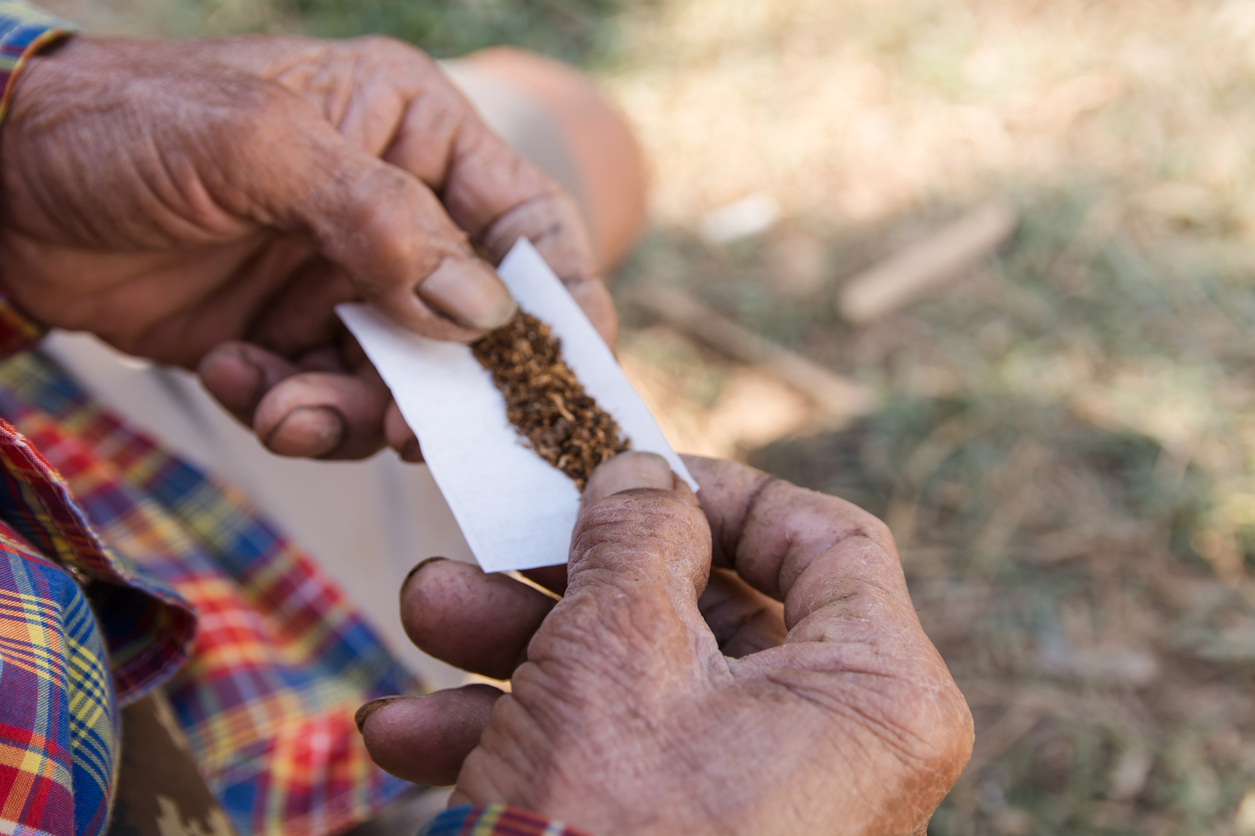I began smoking seriously in 1941, the first summer I worked on the railroad; I was 19. Our paint crew was working up to ten hours a day with only one break — thirty minutes for lunch. If you needed a break you could take a smoke break. Otherwise, it was a long hard day. But no boss ever criticized a guy for taking a few breaks during the day to smoke, even if each break included time to make the cigarette as well as to smoke it.
So, I learned to roll my own and to smoke them — no matter how ugly the “cigs” were. Like most others, I smoked Bull Durham — five cents for 1 oz. of loose leaf chopped tobacco — from Durham, North Carolina, of course. It came in a little cloth bag with a yellow drawstring top that one learned to close with his teeth. It had a picture of a bull on the front and a convenient package of cigarette papers banded to the bag on the back.
The trick was to remove the bag from the bib pocket of your overalls, extract one paper, open the bag with your teeth, roll the paper around the tip of your finger, hold it horizontal, pour the loose chips of tobacco into the paper, draw the string with your teeth to close the bag, and then repocket it with the other hand, all the while sheltering the makings in the lee of your body; roll the paper between the forefinger and thumb of one or both hands (One hand if you wanted to show off), lick the overlap of the paper to moisten it and close it, and finally hold the lumpy beauty at arm’s length to admire it — and look for rips. Twisting the ends to close them pretty much guaranteed a tight but ugly thing ready to smoke.
All this was done in the high winds of western Kansas where we worked. So, light it up and take a drag or two before clenching it between your lips and going back to work.
A couple years later came the army. Nothing too good for the “boys” in the service. Or, contrarily, how the Army gave the soldier lots of smokes to ruin his health all the while trying to keep him in good condition, so he could be effective in battle.
While still in the States a G.I. could buy cigarettes in the canteen for a tax-free five cents a pack. (That probably still allowed a small profit.) Overseas, cigarettes became even more available and were either free or dirt cheap. The tobacco corporations, of course, underwrote this for the practical reason of assuring no one lost the habit while serving their country.
When we were sick and tired of eating C rations from tin cans (packed in the 1930’s) the nice Quartermaster brought us the latest emergency meals — K-rations. One meal per box: B, D, and S (Clue: “S” means supper). And each box had a camouflaged, brown package of four cigarettes to sustain our habit until the next meal.
Whatever the motives behind having cigarettes so prevalent, there really was something comforting to the smoker about lighting up.
I believe to stop for a smoke brought a moment of normalcy, a few moments of comfort to an otherwise abnormal situation. But it was best if you were totally conscious of what you were doing — the smoking ritual. I remember one situation somewhere in Belgium, where I was hungry and cold, in which I smoked a few cigarettes during a long night. Though I was crouched in the bottom of a deep foxhole I curled my body over the lighter each time, so no light would escape. I took long, leisurely draughts, and the warm glow took me back to warmer, saner places for a few minutes.
Our Quartermaster wasn’t always able to supply a lot of our needs, for blankets for example, but we never ran out of cigarettes. I passed near the kitchen truck just as one of the cooks colored the air with his language after he stumbled over a box of cigarettes. He said to me, “We’ve got five big boxes of cigarettes here that are taking up space. This is a kitchen truck. We need the room. I’m going to throw them off.” I said, “Go ahead; toss ‘em.”
Over the tailgate, they went. Five boxes, maybe 100 or more cartons each, worth maybe ten thousand dollars on the streets of Paris. Into the ditch, into the snow. Lucky the guy who found them; hopefully it was a civilian. My pack-a-day habit lasted another fifteen years until one day I quit cold turkey — to stop my hands from shaking.









